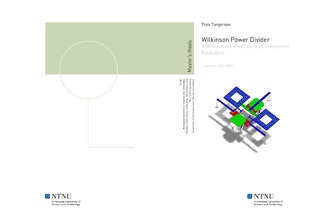Wilkinson Power Divider: A Miniaturized MMIC Lumped Component Equivalent
Master thesis
Permanent lenke
http://hdl.handle.net/11250/2369418Utgivelsesdato
2009Metadata
Vis full innførselSamlinger
Sammendrag
This report will describe the simulation of a Wilkinson Power Divider, realised using lumped components to minimize its size. Every step in the process, from calculating the lumped component values to the final momentum s-parameter simulation is discussed. All relevant theory is described in the theory section. The main goal of this project is to produce the Wilkinson Power Divider using TriQuints 0.5 um TQPED process in as small area as possible. The response of the circuit should also be made as close as possible to the ideal Wilkinson Power Divider. An important additional goal is to learn to use a relevant high-frequency design tool (Agilent ADS) and to get a good understanding of MMIC technology, including the components used and various effects such as cross-talk. During the project a practical measurement on components produced using the TriQuint process will be done, which gives a good understanding of practical measurements using probe station and network analyzer. The final layout, that is arrived at in three steps from a regular Wilkinson Power Divider, should be ready for production, and shows good performance while occupying only a 403 um * 271 um area. The design is thoroughly simulated using Momentum simulation and compared to the ideal response. Any discrepancy between the two responses is explained and commented. All the measurements is compared to simulation results, and deviations between the two is pointed out, and the most probable causes of these are described.
